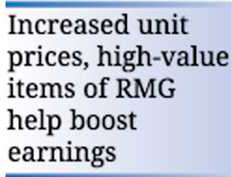The export earnings grew by 5.89 per cent to US$ 5.13 billion year-on-year in January this year defying all odds, including the global economic slowdown.
The country received $4.85 billion from merchandise shipments in January last year, according to official data released on Thursday.
The earnings rose on the back of a hefty growth of apparel shipments thanks to the biggest export industry that kept its wheels rolling amid the global slowdown fuelled by rising inflation and the Russia-Ukraine war, industry people said.
In January 2023, the country fetched $4.42 billion from RMG exports, according to Export Promotion Bureau (EPB) data.
The overall earnings, however, fell 2.10 per cent short of the target set for the last month.
Since September 2021, the single-month export earnings had been surpassing $4.0 billion-mark while it crossed $5.0 billion-mark in November 2022 and the upward trend continued until last January.
Besides, the overall merchandise exports during the first seven months of the current fiscal year (FY 2022-23) registered a growth of 9.81 per cent to $32.44 billion.
The overall export earnings during the July-January period of FY 2021-22 were $29.54 billion.
During the July-January period of this FY, the RMG sector alone fetched $27.41 billion, recording a 14.31 per cent growth compared to the corresponding period of the last FY.
The sector's earnings also exceeded the target set for the July-January period of FY '23 by 4.76 per cent.
The country earned $23.98 billion from apparel exports in the corresponding period of FY '22.
Of the RMG sector, the knitwear subsector earned $14.96 billion in the first seven months of FY '23, registering a growth of 12.70 per cent.
Earnings from woven garments amounted to $12.45 billion, up by 16.30 per cent. Home textiles, however, witnessed about 16.65 per cent negative growth to $692.86 million.
When asked, Bangladesh Garment Manufacturers and Exporters Association (BGMEA) president Faruque Hassan expressed satisfaction over the apparel sector's performance.
He would like to term the performance 'very good' considering the local and global challenges especially when global demands are plummeting mainly because of high inflation and the Russia-Ukraine war.
"Export earnings have been increasing as we are now shipping value-added items, and also because of the rise in the unit prices due to high costs of raw materials and other logistics," he said.
Previously, Bangladesh mostly produced low-cost garment items but nowadays it manufactures high-value items, he explained. This is because of branding the sector that has helped bring mid-to high-value orders, he noted.
The BGMEA president, however, said the exports in terms of quantity have not increased.
There are many factories that don't have sufficient work orders and they are running below their production capacity during the last couple of months in absence of work orders and other reasons, he said.
There are also some factories running without overtime, he added.
Though the work orders have slowed down recently, the growth is sustained by the value-added items, enhanced unit price and better performance in non-traditional markets along with the traditional ones, he noted.
 Talking to the FE, home textile makers, however, said the COVID pandemic had created a huge demand for their goods, but gradually declined afterwards with the resumption of the economic activities.
Talking to the FE, home textile makers, however, said the COVID pandemic had created a huge demand for their goods, but gradually declined afterwards with the resumption of the economic activities.
The ongoing war created an uncertainty due to the higher oil and food prices, forcing the consumers to prioritise essentials like food, they noted.
Meanwhile, the jute sector that demonstrated a positive growth throughout the last FY experienced a negative growth during the first seven months of this FY.
During the period, exports of jute and jute goods dropped 21.22 per cent to $548.10 million from $695.73 million in the same period of the last FY.
When asked, Bangladesh Jute Mills Association secretary general Abdul Barik Khan ascribed multiple factors, including the Indian anti-dumping duty, to this fall in export earnings.
The sector is also deprived of required policy support as the mandatory jute packaging act is yet to be implemented fully while being an agricultural product, jute is yet to enjoy the benefits given to other agricultural goods, Mr Khan alleged.
Earnings from the agricultural items like vegetables, fruits and dry foods witnessed a negative growth of about 25.86 per cent to $555.27 million during the July-January period of FY '23.
Earnings from pharmaceutical exports stood at $106.73 million, registering an 8.86 per cent negative growth.
Bangladesh fetched $733.09 million from export of leather and leather goods in July-January period of FY '23, registering a 7.37 per cent growth.
Export earnings from frozen and live fishes decreased by 22.83 per cent to $291.65 million in the same period.
Talking to the FE, frozen and live-fish exporters attributed this downswing in demand for fish products in the upmarket, mainly in the European Union, to the influence of hyperinflation amid the war.
They also attributed it to the failure in introducing low-cost varieties of shrimp like vannamei despite making several attempts over the years.
According to the EPB data, exports of plastic products witnessed a 40.12 per cent growth to $122.44 million.


